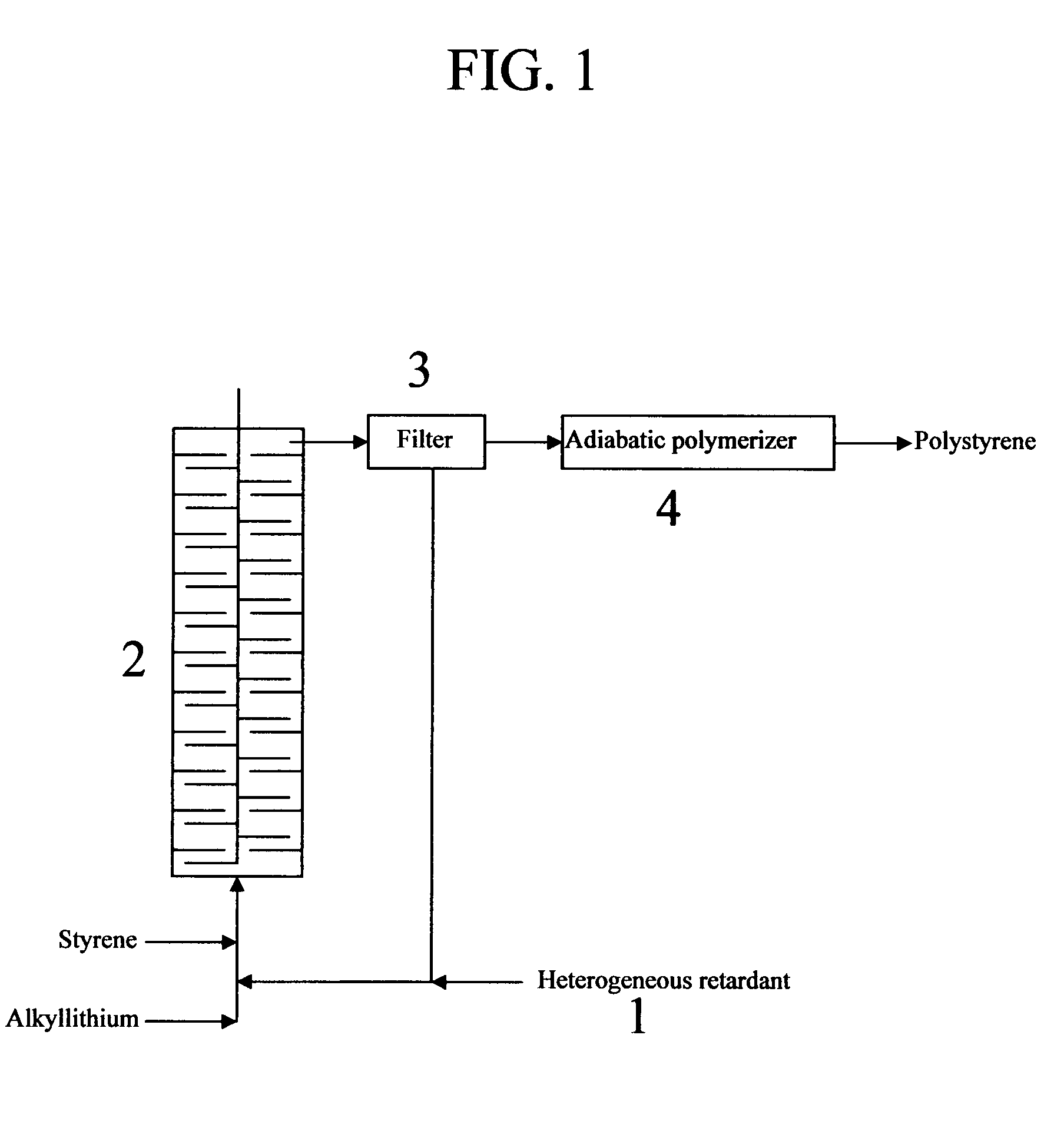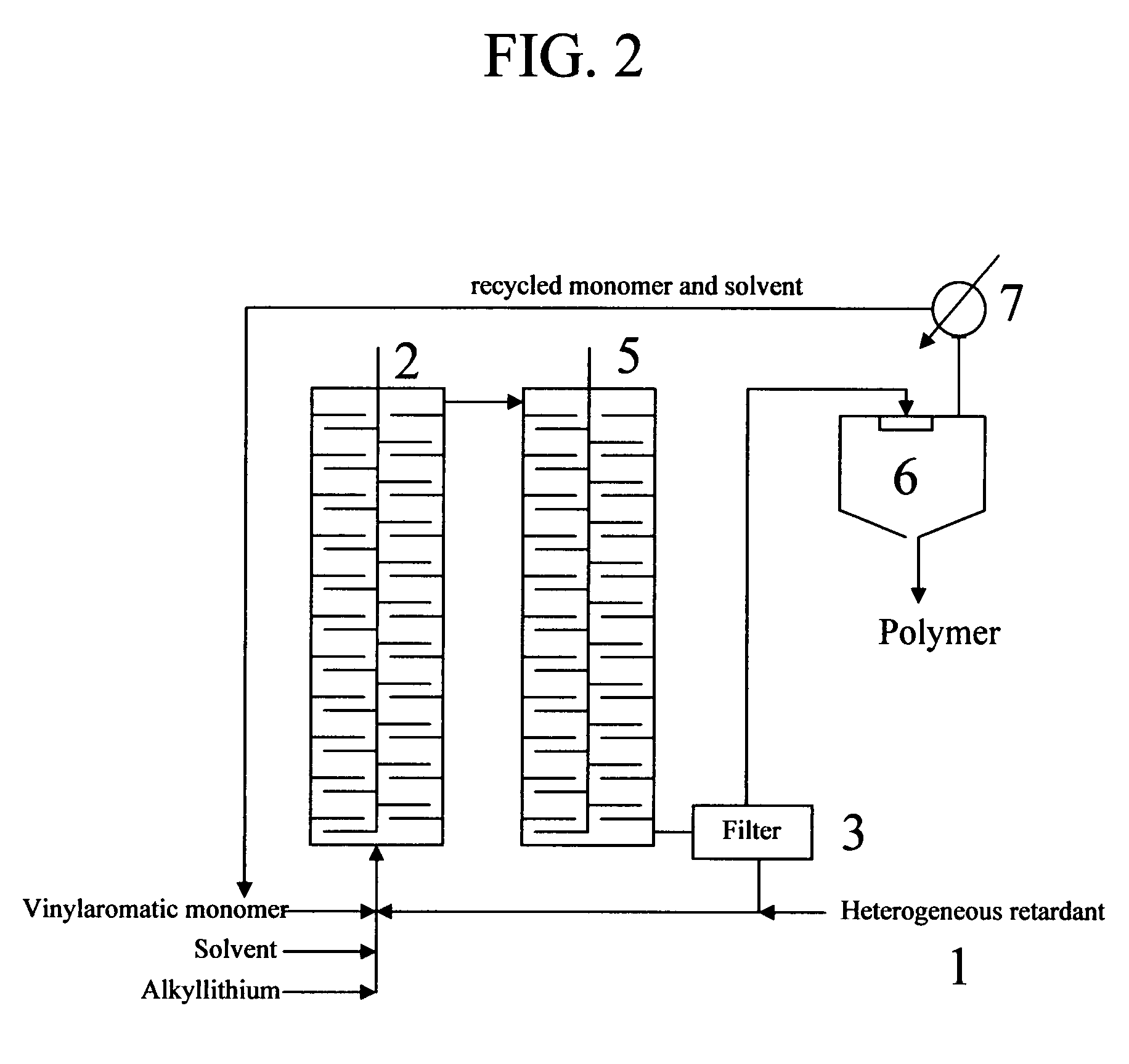Retarded anionic polymerization of vinyl aromatic monomers using insoluble or heterogeneous retardants
a technology of insoluble or heterogeneous retardants and anionic polymerization, which is applied in the field of retarded anion, can solve the problems of high level of solvent or special process technology, high cost and poor quality of polymer, and achieve the effects of reducing the use of retardant materials, reducing the rate of polymerization, and improving the quality of the polymer
- Summary
- Abstract
- Description
- Claims
- Application Information
AI Technical Summary
Benefits of technology
Problems solved by technology
Method used
Image
Examples
example 1
Preparation of Heterogeneous Retardant
[0035]Dowex MSA1 macroporous anion exchange beads (500 g) are placed in a 2 L round-bottom flask equipped with a Dean Stark trap, heating mantle, bottom drain valve, septum, and mechanical stirrer. Toluene (500 mL) is added. Heat is applied with stirring and water is removed. When no more water can be removed, the Dean Stark trap is replaced by a dry nitrogen inlet. The contents of the flasks are placed under a dry nitrogen atmosphere. Triisobutyaluminum (10 ml of a 15% by weight solution) is injected into the slurry of beads. After stirring for 30 minutes, the liquid is drained from the bottom of the flask. Fresh dry toluene (500 mL) is added and stirring continued for 10 minutes. The liquid is drained from the flask. This washing is continued until the toluene drained from the flask contains <1 ppm of triisobutylaluminum.
example 2
Retarded Anionic Polymerization of 4-methylstyrene
[0036]The heterogeneous retardant prepared in Example 1 (300 g) is transferred under a nitrogen atmosphere into a 1 gallon agitated reactor. The reactor is filled with a solution consisting of 20% toluene and 80% 4-methylstyrene. The mixture is heated and stirred at 100 deg.C. for 2 h to achieve a viscous syrup containing 55% solids. The syrup is pumped from the reactor and into a 1-inch extruder heated at 180 deg.C. A filter element is located in the transfer line to retain the heterogeneous retardant. A vacuum of 5 mmHg is pulled on the extruder to remove volatile components. The molten polymer is extruded through a die and the strand is cut into granules.
example 3
Preparation of Polystyrene
[0037]A 500 mL round bottom flask is equipped with a mechanical agitator, nitrogen inlet and outlet, rubber septum, dropping funnel, and a glass frit filter at the drain outlet on the bottom of the flask. Anhydrous silica gel particles (10 g) having an average particle size of 0.5 mm is placed in the flask. Dry hexane (100 mL) is added to the flask. Stirring is started to create a slurry. A 15% by weight solution of dibutylmagnesium in hexane (1 mL) is injected into the flask using a syringe. After stirring at ambient temperature for 30 min., agitation is stopped and the liquid drained from the flask through the drain valve. Fresh hexane (200 mL) is added to the flask and agitation begun for 15 min. followed by draining. This hexane washing of the dibutylnagnesium / silica gel heterogeneous retardant is repeated twice more to insure that all of the soluble material is removed. Anhydrous styrene (200 mL) is then added to the flask and agitation begun. A 15% by...
PUM
| Property | Measurement | Unit |
|---|---|---|
| temperature | aaaaa | aaaaa |
| particle size | aaaaa | aaaaa |
| diameter | aaaaa | aaaaa |
Abstract
Description
Claims
Application Information
 Login to View More
Login to View More - R&D
- Intellectual Property
- Life Sciences
- Materials
- Tech Scout
- Unparalleled Data Quality
- Higher Quality Content
- 60% Fewer Hallucinations
Browse by: Latest US Patents, China's latest patents, Technical Efficacy Thesaurus, Application Domain, Technology Topic, Popular Technical Reports.
© 2025 PatSnap. All rights reserved.Legal|Privacy policy|Modern Slavery Act Transparency Statement|Sitemap|About US| Contact US: help@patsnap.com


